Wagah-Attari border ceremony
The lowering of the flags ceremony at the Wagah border is a daily military practice that the security forces of India (Border Security Force, BSF) and Pakistan (Pakistan Rangers) have jointly followed since 1959.[1] The drill is characterized by elaborate and rapid dancelike manoeuvres and raising legs as high as possible, which have been described as "colourful".[1] It is alternatively a symbol of the two countries’ rivalry, as well as brotherhood and cooperation between the two nations. Similar parades are being organised at Mahavir/Sadqi border near Fazilka and Hussainiwala/Ganda Singh Wala border near Firozpur.
| Wagah Attari Border Ceremony ਵਾਗਾਹ ਅਟਾਰੀ ਸਰਹੱਦ ਸਮਾਰੋਹ वागह अटारी सीमा समारोह واہگہ سرحد تقریب | |
|---|---|
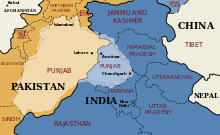 Wagah is a village situated in Lahore District[2] and lies on the old Grand Trunk Road between Lahore, Punjab, Pakistan and Amritsar, India. It serves as a goods transit terminal and a railway station between Pakistan and India. | |
| Genre | Military display |
| Dates | Every day |
| Years active | Since 1959 |
| Founded | Border Security Force and Pakistan Rangers |
Overview
Coordinates: 31°36′17″N 74°34′23″E / 31.604644°N 74.573080°E
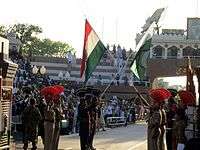
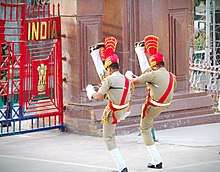
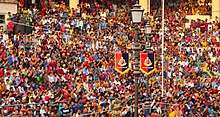
This ceremony takes place every evening immediately before sunset at the Wagah border, which as part of the Grand Trunk Road was the only road link between these two countries before the opening of the Aman Setu in Kashmir in 1999. The ceremony starts with a blustering parade by the soldiers from both sides, and ends up in the perfectly coordinated lowering of the two nations' flags.[3] It is called the Beating Retreat border ceremony on the international level. One infantryman stands at attention on each side of the gate. As the sun sets, the iron gates at the border are opened and the two flags are lowered simultaneously. The flags are folded and the ceremony ends with a retreat that involves a brusque handshake between soldiers from either side, followed by the closing of the gates again. The spectacle of the ceremony attracts many visitors from both sides of the border, as well as international tourists.[3] In October 2010, Major General Yaqub Ali Khan of the Pakistan Rangers decided that the aggressive aspect of the ceremonial theatrics should be toned down. The soldiers of this ceremony are specially appointed and trained for this auspicious ceremony. They also have a beard and moustache policy for which they are paid additionally.
2014 suicide attack
On 2 November 2014, approximately 60 people were killed and at least 110 people were injured in a suicide attack on the Pakistan side of the Wagah border. An 18- to 20-year-old attacker detonated a 5 kg (11 lb) explosive in his vest 500 metres (1,600 ft) from the crossing point in the evening right after the Wagah border ceremony ended.[4][5]
2016 Indo-Pakistani tensions
After the India–Pakistan military confrontation on 29 September 2016 the border closing ceremony continued, but on the Indian side public attendance was denied on the evenings between 29 September and 8 October 2016.[6] As a sign of the increased tensions, the BSF did not exchange sweets and greetings with Pakistani Rangers on Diwali 2016, despite a long tradition of doing so on major religious festivals like Bakr-Eid and Diwali, and also during Independence Days of both countries.[7]
Other places
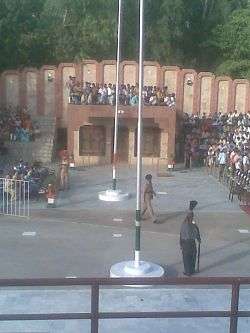
These border ceremonies done by the Pakistan Rangers and BSF just before sunset are not only carried out at Wagah, but it is also done at other India-Pakistan border posts, such as at the:
- Ganda Singh Wala border, Kasur District (Pakistan side) / Hussainiwala border, Punjab (India side)
- Sulaimanki, Punjab (Pakistan side) / Fazilka border, Okara District (India side)
These ceremony which is other than Wagah are carried out in a smaller setting, and spectators tend to originate from local Punjabis rather than at the Wagah where Indians/Pakistanis from different states come to gather with some foreign tourists. The method of drill and parade is also quite different compared to the one in Wagah. Border soldiers from both sides also intimidate each other by throwing high-kicks and by staring, and is concluded by a flag retreat done from the both sides together.
See also
- Attari, the Indian village bordering with Wagah
- Borders of India
References
- 1 2 Khaleeli, Homa (1 November 2010). "Goodbye to the ceremony of silly walks between India and Pakistan". The Guardian. Retrieved 14 November 2011.
- ↑ "Mixed feelings on India-Pakistan border". BBC News. 14 August 2007.
- 1 2 Frank Jacobs (3 July 2012). "Peacocks at Sunset". Opinionator: Borderlines. The New York Times. Retrieved 15 July 2012.
- ↑ "Pakistan blast 'kills 45' at Wagah border with India". BBC News. 2 November 2014. Retrieved 2 November 2014.
- ↑ "Police: Suicide bomber kills dozens at Pakistan border parade". CNN. 2 November 2014. Retrieved 2 November 2014.
- ↑ "Attari-Wagah post echoes with patriotic chants again". hindustantimes. 9 October 2016. Retrieved 6 November 2016.
- ↑ "BSF refuses to exchange Diwali sweets at Wagah as Indo-Pak tension increases". The Economic Times. 30 October 2016. Retrieved 6 November 2016.
External links
| Wikimedia Commons has media related to Wagah Border. |
- Michael Palin at the India-Pakistan border ceremony on the Pakistani side (from Himalaya with Michael Palin). BBCWorldwide video on YouTube.
- Sanjeev Bhaskar at the India-Pakistan border ceremony on the Indian side. BBCWorldwide video on YouTube.